Feijoada is a Brazilian black bean stew with pork cuts served with white rice, farofa (toasted cassava flour), couve a mineira (pan-fried collard greens), and orange slices. It is the national dish of my home country, Brazil. Our feijoada recipe can be made 3 ways: on the stovetop, in the slow cooker, and in a pressure cooker. So come along and learn from this Brazilian native and chef just how to make the best feijoada that you will ever have! WATCH OUR QUICK VIDEO!
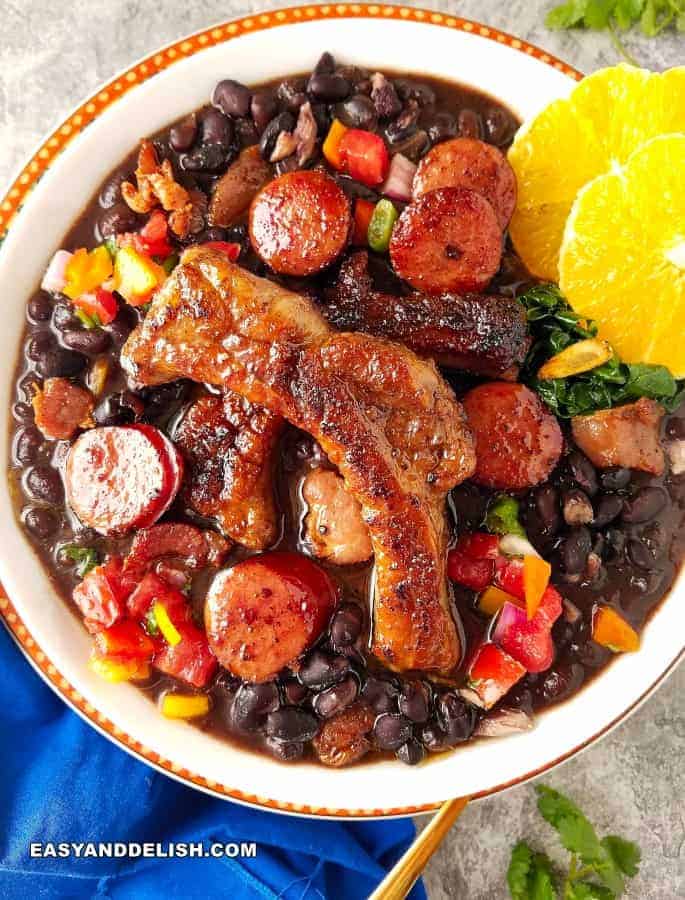
Table of Contents
- 1 HOW TO MAKE FEIJOADA (BRAZILIAN BLACK BEAN AND PORK STEW)
- 2 INGREDIENTS AND SUBSTITUTIONS
- 3 HOW DO YOU PRONOUNCE FEIJOADA, THE NATIONAL DISH OF BRAZIL?
- 4 WHAT IS BRAZILIAN FEIJOADA MADE WITH?
- 5 BRIEF HISTORY
- 6 WHERE DOES THE RECIPE FOR FEIJOADA COME FROM?
- 7 WHAT IS BRAZIL’S NATIONAL DISH?
- 8 WHAT DOES IT TASTE LIKE?
- 9 WHAT TO SERVE WITH?
- 10 WHAT DRINK IS FEIJOADA SERVED WITH IN BRAZIL?
- 11 WHEN TO EAT FEIJOADA?
- 12 WHAT IS CHOURIÇO SAUSAGE?
- 13 WHAT’S THE DIFFERENCE BETWEEN CHOURIÇO AND LINGUIÇA?
- 14 WHAT IS VINAGRETE (BRAZILIAN VINAIGRETTE)?
- 15 THE DIFFERENCE BETWEEN PORTUGUESE FEIJOADA AND BRAZILIAN FEIJOADA
- 16 TYPES OF FEIJOADA AROUND THE WORLD
- 17 VARIATIONS
- 18 WHAT DOES MASHING/BLENDING COOKED BEANS DO TO THE FEIJOADA STEW?
- 19 HOW TO STORE
- 20 COOK'S NOTES FOR BRAZILIAN FEIJOADA RECIPE
- 21 OTHER BEANS RECIPES:
- 22 Feijoada Recipe (Brazilian Black Bean Stew)
If you love black beans and pork, you’ll go cuckoo crazy for feijoada. It’s hearty, comforting, and full of soul... It is THE soul food of Brazil.
HOW TO MAKE FEIJOADA (BRAZILIAN BLACK BEAN AND PORK STEW)
- Each of the 3 methods below calls for the same ingredients, but they use different cooking times and techniques. Learn how to cook an easy feijoada stew in the slow cooker, pressure cooker, and on the stovetop.
- (OPTIONAL) Soaking: Soak beans with enough water to cover them by 3 inches. Place them in the fridge or leave at room temp overnight (8 hours), adding more water if needed. But you can skip this step by adding 1 teaspoon of baking soda to the beans when cooking.
- The first step is to sort and rinse the black beans. Then, follow one of the cooking methods below.
SLOW COOKER FEIJOADA RECIPE
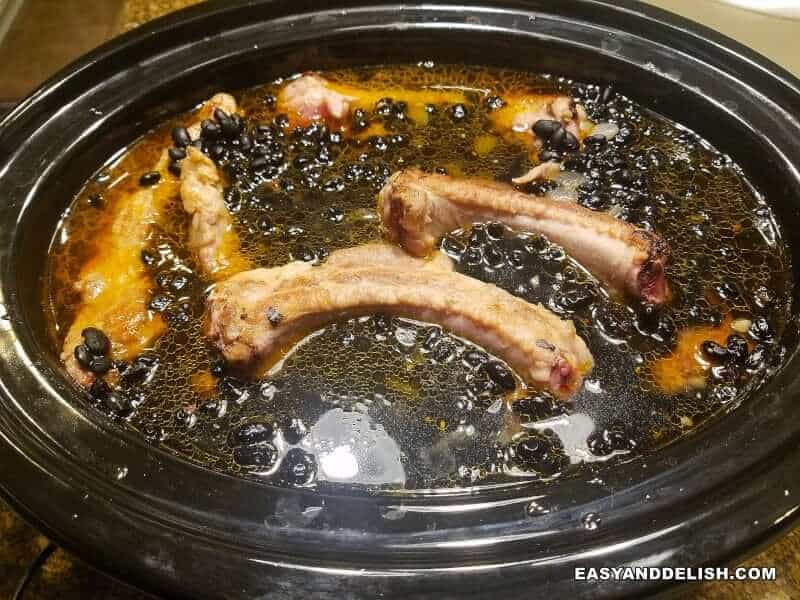
- Heat a large nonstick pan over medium-high heat. Add the bacon and cook for 5-6 minutes, or until browned. Transfer to a large bowl.
- Next, cook the sausage for about 5 minutes, or until browned. Transfer to the bowl with the bacon. If needed, add half of the oil and brown the ribs, about 4 minutes per side. Transfer to the bowl with the bacon and sausage. Reserve.
- Reduce the heat to medium, add the other half of the oil, and cook the onion for 5-6 minutes or until softened, stirring every now and then. Add garlic and cook for 1 minute or until fragrant, stirring often.
- Transfer half of the veggie mixture to the slow cooker, stir in beans, water, baking soda (only if you didn’t soak the beans), cumin, the reserved meats, and bay leaf.
- Cover and cook on high for 2-4 hours or on low for 8-10 hours. A half-hour before cooking time ends, stir in the other half of the cooked onion/garlic, salt, pepper, and tomato paste. Let cook until the beans are tender.
- Remove bay leaf, adjust salt if needed, and stir in vinegar. Transfer about ½ cup of beans with their broth to a blender and blend until smooth. Mix with the feijoada. Sprinkle chopped cilantro on top and serve.
PRESSURE COOKER FEIJOADA RECIPE

- To make this feijoada recipe in the Instant Pot, press the saute function. Once heated, add bacon and cook for 5-6 minutes or until browned. Transfer to a large bowl.
- Next, cook the sausage for about 5 minutes, or until browned. Transfer to the bowl with the bacon. If needed, add half of the oil and brown the ribs, about 4 minutes per side. Transfer to the bowl with the bacon and sausage. Reserve.
- Add the other half of the oil if needed and cook the onion for 5-6 minutes or until softened, stirring every now and then. Add garlic and cook for 1 minute or until fragrant, stirring often.
- Stir in beans, water, baking soda (only if you didn’t soak the beans), cumin, the reserved meats, and the bay leaf in the pressure cooker. Cancel saute.
- Lock the lid and cook on high pressure for 30 minutes. Natural release pressure (about 20 minutes) and unlock the lid.
- Remove bay leaf, season well with salt and pepper, and stir in both the tomato paste and the vinegar. Transfer about 1-2 cups of beans with their broth to a blender and blend until smooth. Mix with the feijoada. Sprinkle chopped cilantro on top and serve.
Curious about how does a pressure cooker work? Get our cooking time charts!
STOVETOP FEIJOADA RECIPE
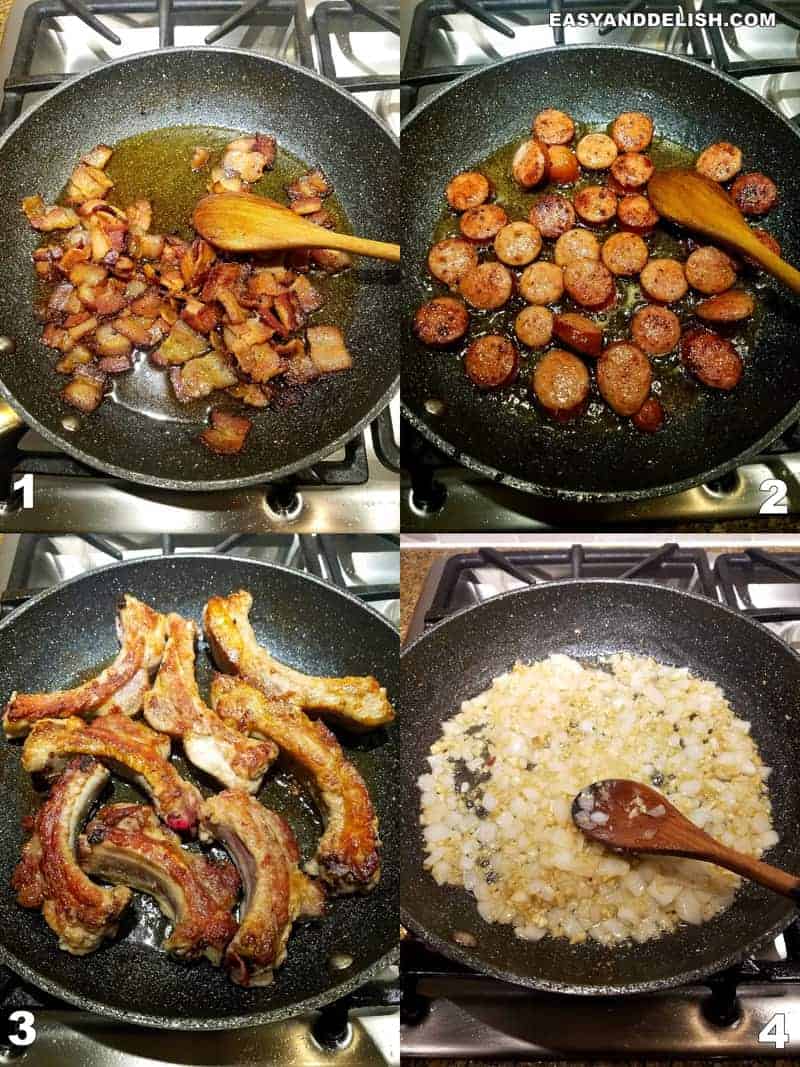
- Heat a large nonstick pot over medium-high heat. Add the bacon and cook for 5-6 minutes or until browned (SEE PIC.1). Transfer to a large bowl.
- Then cook the sausage for about 5 minutes, or until browned (SEE PIC.2). Transfer to the bowl with the bacon.
- If needed, add half of the oil and brown the ribs, about 4 minutes per side (SEE PIC.3). Transfer to the bowl with the bacon and sausage. Reserve.
- Reduce the heat to medium heat, add the other half of the oil, and cook the onion for 5-6 minutes or until softening, stirring every now and then. Add garlic and cook for 1 minute or until fragrant, stirring often (SEE PIC.4).
- Transfer half of the veggie mixture to a small bowl and reserve. Stir in beans, water, baking soda (only if you didn’t soak the beans), cumin, the reserved meats, and bay leaf.
- Increase heat to high and bring to a boil. Reduce heat to medium-low, stir, and cover. Cook for 60-90 minutes or until beans are almost tender. Stir in the other half of cooked onion/garlic salt, pepper, and tomato paste. Let cook for 10-15 minutes, or until beans are tender.
- Remove bay leaf, adjust salt if needed, and stir in vinegar. Transfer about ½ cup of beans with their broth to a blender and blend until smooth. Mix with the feijoada. Sprinkle chopped cilantro on top and serve.
INGREDIENTS AND SUBSTITUTIONS
- Olive oil -- Or any other vegetable oil. It helps to brown the meats and reduces foaming.
- Onion -- Use either yellow or white onion to flavor the beans.
- Garlic -- It flavors the beans along with the onions and spices.
- Black beans -- Make sure to sort them first in order to remove any spoilage or broken beans. It's best to cook beans that are new. The older they are, the more time to cook them.
- Water -- I prefer to use broth to make a more flavorful feijoada.
- Sausage -- In Brazil, paio (cured smoked pork and beef sausage) and Calabresa (spicy pork sausage) are the most common sausages used to make this dish. But you can use one that you enjoy!
- Bacon -- Use smoked, thick-cut bacon. If you want to, add the ham hock and beef jerky to the recipe.
- Baby pork ribs (or baby back ribs) -- They fall off the bone once cooked and add more flavor to this bean stew.
- Tomato paste -- It is one of the acidic ingredients added to the dish. It must be added only after the beans are cooked; otherwise, it can toughen the beans, requiring more time to cook.
- Bay leaf
- Salt, pepper, and cumin -- the most common seasonings used by Brazilians to season the beans. Only add salt at the end; otherwise, it will toughen the beans.
- Vinegar -- Use red wine vinegar to bring all the flavors together after the beans are cooked only.
- Cilantro (optional) -- It gives a touch of freshness to the dish. Some enjoy adding hot sauce or malagueta pepper to this traditional stew but this is a personal preference only!
FREQUENT ASKED QUESTIONS
HOW DO YOU PRONOUNCE FEIJOADA, THE NATIONAL DISH OF BRAZIL?
Feijoada (Portuguese pronunciation: fāˈjwädə) comes from the word “feijão” which means “beans.” But it is not to be confused with feijoa, which is a fruit related to guavas.
WHAT IS BRAZILIAN FEIJOADA MADE WITH?
The traditional Brazilian feijoada is made with black beans and pork trimmings such as pig’s ears, trotters, and tails, as well as ham hocks, all stewed together on the stovetop. However, the modern feijoada recipe takes black beans and some pork meats such as ham hock, bacon, ribs, sausage (paio and calabresa), chunks of pork loin, and sometimes beef meats such as carne seca (jerked beef). The beans and meats are stewed together with seasonings, commonly in a pressure cooker.
In contrast, vegan or vegetarian feijoada calls for black beans and vegetables. These can be stewed together in a slow cooker, pressure cooker, or on the stovetop.
BRIEF HISTORY
Historians argue over its origins. Some say feijoada was invented in Portugal, and then later the settlers brought it to their colonies, such as Brazil and Mozambique. Others assure us that it was slaves in Brazil that created the authentic feijoada — they cooked leftover beans with humble cuts of meats that their owners didn’t want to, such as pig’s ears, tail, tongue, and trotters.
To make matters worse, the place of origin within Brazil is also in dispute. Some attest that feijoada comes from Pernambuco state (there is mention of it in 1827 in a local newspaper), while others say that it comes from Bahia.
Whatever its place of origin, feijoada is Brazil’s national dish, enjoyed the entire year by people from all social classes.
WHERE DOES THE RECIPE FOR FEIJOADA COME FROM?
Some affirm that the recipe for feijoada comes from Portugal, while others say it comes from Brazil. The fact is, there are different versions of the dish both in Brazil and Portugal, as well as a version in Angola, Mozambique, East Timor, and Macau.
Feijoada is also related to the French cassoulet.
WHAT IS BRAZIL’S NATIONAL DISH?
Feijoada is the national dish of Brazil, my home country! The recipe varies from place to place in Brazil, but it’s enjoyed all over Brazil the whole year.
WHAT DOES IT TASTE LIKE?
It tastes like smoked black beans due to the pork meats it contains. It is earthy and savory, with a thick bean broth and chunky meats.
WHAT TO SERVE WITH?
Serve feijoada with white rice, Farofa (toasted cassava flour), Couve a Mineira (sauteed collard greens), vinagrete (mild pico de gallo), and orange slices. Boiled cassava, yuca fries, and deep-fried bananas are also sometimes served as side dishes for feijoada.
WHAT DRINK IS FEIJOADA SERVED WITH IN BRAZIL?
You serve it with caipirinha – Brazil’s national cocktail, which is made of mashed lime wedges with sugar, ice, and cachaca. For a virgin drink, serve feijoada with Brazilian lemonade.
WHEN TO EAT FEIJOADA?
Weekends are the time when Brazilian feijoada is most frequently served. The main reason is because it takes some time to cook the feijoada itself, as well as the side dishes to go with it. Another reason is it's a heavy dish that requires an extended lunch period to digest.
Some bars and self-service restaurants in Rio and São Paulo serve feijoada completa on Wednesdays and Saturdays. However, these are not only the days that feijoada is enjoyed in Brazil.
Brazilian Carnival is another great occasion to enjoy feijoada.
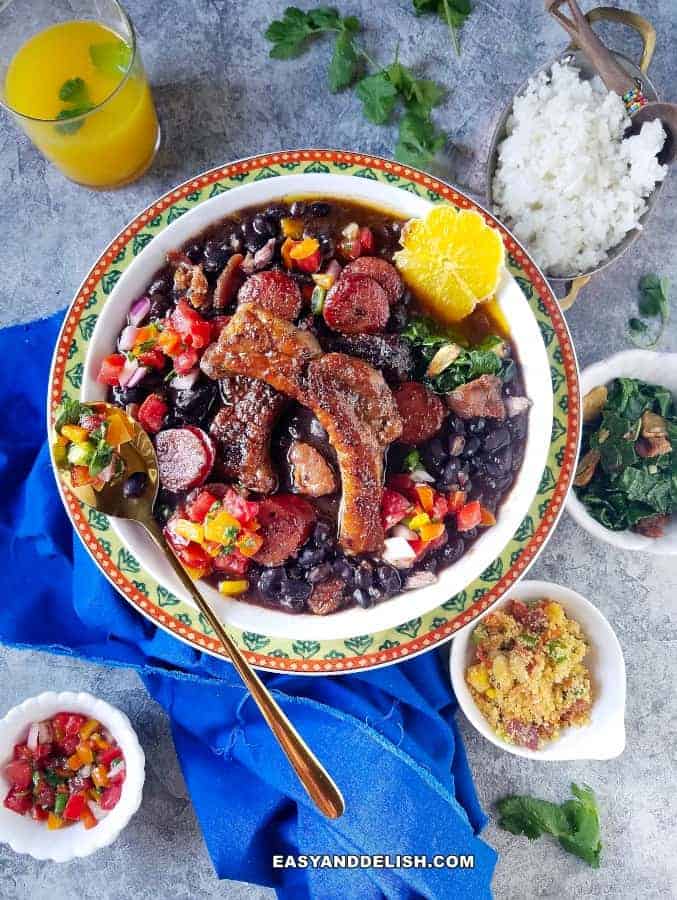
WHAT IS CHOURIÇO SAUSAGE?
Chouriço is a dry smoked Portuguese sausage made of pork meat and fat, seasonings such as salt and paprika, and depending on the type, onion (chouriço de cebola), blood (chouriço de sangue), or wine (chouriço de manu).
It is not to be confused with Spanish chorizo, a sausage made of pork meat and pork fat, garlic, and pimentón – smoked paprika. It can be either picante (spicy) or dulce (sweet), depending on the type of pimentón used.
WHAT’S THE DIFFERENCE BETWEEN CHOURIÇO AND LINGUIÇA?
Chouriço is spicy sausage while linguiça is mild.
Although both chouriço and linguiça are Portuguese smoked sausages made with garlic and paprika, chouriço is spicy while linguiça is mild. Both can be used to make Brazilian feijoada.
Like chouriço, linguiça also has a variant called linguiça calabresa, made with Calabrese pepper by Italian immigrants. This type is used in pizzas and is spicier than Portuguese linguiça.
WHAT IS VINAGRETE (BRAZILIAN VINAIGRETTE)?
Vinagrete is the Brazilian equivalent of pico de gallo. It is made with chopped onion, tomato, bell pepper, and cilantro mixed with oil and lime juice. Unlike its Mexican cousin, pico de gallo, it is mild because it contains no jalapeños. It is one of the sides that go along with feijoada.
THE DIFFERENCE BETWEEN PORTUGUESE FEIJOADA AND BRAZILIAN FEIJOADA
In Portugal, feijoada is made with either navy beans (Minho e Douro Litoral) or red kidney beans (Trás-os-Montes). This feijoada also features vegetables (carrots, cabbage, tomatoes) in addition to the beef/pork meats.
In contrast, in Brazil, feijoada is mostly made with black beans (although in Bahia it can be made with pinto beans). The beans are stewed mostly with pork meats, and sometimes cuts of beef. The only vegetables in the dish are those that compose the Brazilian version of sofrito, consisting of garlic, onion, and bay leaf.
TYPES OF FEIJOADA AROUND THE WORLD
- Brazilian feijoada – made of black beans and pork meats (and sometimes beef cuts).
- Portuguese feijoada à transmontana, with red kidney beans, pork meats, and vegetables such as cabbage and carrots,
- Portuguese feijoada poveira-- made of cannellini beans, pork and beef meats, and veggies such as carrots and tomatoes.
- Mozambican feijoada à moda do Ibo-- made of crowder peas, chicken, and shrimp.
- Brazilian maniçoba, also known as "feijoada paraense," is a stew from the Amazonian region made of manioc leaves (instead of beans), pork meats, and beef cuts.
- Angolan Feijoada - made of butter beans, fumbwa green leaves, veggies, chicken, and chouriço.
- Macanese feijoada, made of red kidney beans, pork trimmings, and veggies.
- Goan feijoada, with red kidney beans, masala, curry leaves, green chilies, and beef/pork sausage.
- Timorese feijoada, stewed with white beans, pork meats, and veggies.
Some list cachupa as a variation of feijoada, but it is a dish from Cabo Verde that is closer to Brazilian mungunzá (a bean and corn stew with meats) rather than feijoada.
VARIATIONS
- Traditional feijoada – made of black beans and pork trimmings (such as pig’s ears, trotters, and tails)
- Modern Feijoada – this contains black beans, pork meats, and sometimes beef meats. Very common in Rio de Janeiro, Minas Gerais, and most of Brazil.
- Regional feijoadas – there are 2 types. A) one made with pinto beans and pork/beef meats in Bahia State. Sometimes plantains, collard greens, potatoes, cabbage, and pumpkin may be added to feijoada there. B) another version, maniçoba, is from Para State, in the Amazonian region, in which no beans are used in the stew. Instead, the stew is prepared with manioc leaves and pork/beef meats.
WHAT DOES MASHING/BLENDING COOKED BEANS DO TO THE FEIJOADA STEW?
This is an old secret trick. Brazilians mash or simply blend a small number of cooked beans in the blender (½ to 2 cups depending on the amount of cooked beans) in order to make the feijoada broth thicker. It works because it releases some of the starch from the beans.
HOW TO STORE
Store feijoada in an airtight container in the fridge for up to 3-4 days. Freeze it for up to 4 months. Thaw in the fridge and reheat well before serving.
COOK'S NOTES FOR BRAZILIAN FEIJOADA RECIPE
- Feijoada tastes better on the second day.
- The white rice that we serve this black bean and pork stew with is parboiled long-grain rice.
- You may replace shredded chicken with beef.
- This feijoada recipe is gluten-free, dairy-free, and a high-protein dish!
OTHER BEANS RECIPES:
- Vegetarian feijoada
- Feijoada Salad
- Brazilian Minestrone
- Black Beans and Rice
- Pastel de Feijoada
- How to Make Black Beans
- Instant Pot Black Beans
PIN & ENJOY!
Feijoada Recipe (Brazilian Black Bean Stew)
Equipment
- stovetop
- slow cooker
- pressure cooker
Ingredients
- ½ lb thick-cut smoked bacon chopped (SEE NOTES)
- 14 ounces smoked sausage sliced
- 2 pounds pork baby back ribs membrane removed and ribs separated individually
- 2 tablespoon olive oil only If needed
- 1 medium yellow onion chopped
- 6 garlic cloves minced
- 1 pound dry black beans
- 6 cups water Although vegetable or beef broth are preferred to flavor the beans even more
- 1 teaspoon baking soda (only if beans were NOT soaked overnight)
- 1 teaspoon cumin
- 2 bay leaf
- 1 ½ tablespoon salt plus more to taste if needed
- 1 teaspoon ground black pepper
- 2 tablespoon tomato paste
- 2-3 tablespoon red wine vinegar improves taste and reduces gassy elements
- ¼ cup chopped fresh cilantro or parsley optional
Instructions
- (OPTIONAL) Soaking: Soak beans with enough water to cover them by 3 inches. Place them in the fridge or leave at room temp overnight (8 hours), adding more water if needed. But you can skip this step by adding 1 teaspoon of baking soda to the beans when cooking.The first step is to sort and rinse the black beans. Then, follow one of the cooking methods below.
- SLOW COOKER FEIJOADA RECIPE (FAVORITE METHOD): 1) Heat a large nonstick pan over medium-high heat. Add the bacon and cook for 5-6 minutes, or until browned. Transfer to a large bowl. 2) Next, cook the sausage for about 5 minutes, or until browned. Transfer to the bowl with the bacon. If needed, add half of the oil and brown the ribs, about 4 minutes per side. Transfer to the bowl with the bacon and sausage. Reserve. 3) Reduce the heat to medium, add the other half of the oil and cook the onion for 5-6 minutes or until softened, stirring every now and then. Add garlic and cook for 1 minute or until fragrant, stirring often. Transfer half of the veggie mixture to a LARGE slow cooker (8-qt. or larger, or reduce recipe to half to make in a 6-qt. one), stir in beans, water, baking soda (only if you didn’t soak the beans), cumin, the reserved meats, and bay leaf.4) Cover and cook on high for 2-4 hours or on low for 8-10 hours. A half hour before cooking time ends, stir in the other half of the cooked onion/garlic, salt, pepper, and tomato paste. Let cook until beans are tender. 5) Remove bay leaf, adjust salt if needed, and stir in vinegar. Transfer about 1-2 cups cup of beans with their broth to a blender and blend until smooth. Mix with the feijoada. Sprinkle chopped cilantro on top and serve. NOTE: It is my favorite method because it gives the beans time to develop depth of flavor!
- PRESSURE COOKER FEIJOADA RECIPE (QUICK METHOD):1) Press the saute function. Once heated, add bacon and cook for 5-6 minutes or until browned. Transfer to a large bowl. Next, cook the sausage for about 5 minutes, or until browned. Transfer to the bowl with the bacon. 2) If needed, add half of the oil and brown the ribs, about 4 minutes per side. Transfer to the bowl with the bacon and sausage. Reserve. Add the other half of the oil if needed and cook the onion for 5-6 minutes or until softened, stirring every now and then. Add garlic and cook for 1 minute or until fragrant, stirring often. 3) Stir in beans, water, baking soda (only if you didn’t soak the beans), cumin, the reserved meats, and the bay leaf in the pressure cooker. Cancel saute. Lock lid and cook on high pressure for 30 minutes. Natural release pressure (about 20 minutes) and unlock lid. 4) Remove bay leaf, season well with salt and pepper, and stir in both the tomato paste and the vinegar. Transfer about 1-2 cups of beans with their broth to a blender and blend until smooth. Mix with the feijoada. Sprinkle chopped cilantro on top and serve.NOTE: If using this method, please make sure to double the amount of garlic, cumin, pepper, bay leaf, tomato paste, and vinegar. Plus, you can use the method described in the notes below if you want (useful tips/final touch).
- STOVETOP FEIJOADA RECIPE (TRADITIONAL METHOD):1) Heat a large nonstick pot over medium-high heat. Add the bacon and cook for 5-6 minutes or until browned (SEE PIC.1). Transfer to a large bowl.Then cook the sausage for about 5 minutes, or until browned (SEE PIC.2). Transfer to the bowl with the bacon. 2) If needed, add half of the oil and brown the ribs, about 4 minutes per side (SEE PIC.3). Transfer to the bowl with the bacon and sausage. Reserve. 3) Reduce the heat to medium, add the other half of the oil, and cook the onion for 5-6 minutes or until softened, stirring every now and then. Add garlic and cook for 1 minute or until fragrant, stirring often (SEE PIC.4). Transfer half of the veggie mixture to a small bowl and reserve. Stir in beans, water, baking soda (only if you didn’t soak the beans), cumin, the reserved meats, and bay leaf. Increase heat to high and bring to a boil. 4) Reduce heat to medium-low, stir, and cover. Cook for 60-90 minutes or until beans are almost tender. Stir in the other half of cooked onion/garlic salt, pepper, and tomato paste. Let cook for 10-15 minutes, or until beans are tender. 5) Remove bay leaf, adjust salt if needed, and stir in vinegar. Transfer about 1-2 cups of beans with their broth to a blender and blend until smooth. Mix with the feijoada. Sprinkle chopped cilantro on top and serve.
Recipe Video

Recipe Notes
- Additional meats: You can add other meats to our recipe such as ham hock, cubed pork loin, jerked beef, and also less noble parts of the pork such as tail, trots, and ears. But be aware most Brazilians from Generation X and younger do NOT usually have less noble parts in their feijoada. Most restaurants and bars don't serve them either! Older generations (and more humble households) still use not-so-noble parts of the pork in their homemade feijoada. I used to add ham hock to mine but I removed it from the recipe because they often demand more time to cook than the beans themselves (around 5 hours to be tender). You can still add it to the feijoada if cooking yours in the slow cooker on LOW.
- Final touch (re-seasoning): Some Brazilians often season their feijoada again, at the very end (right after the beans cook). In a separate pan, they sauté lots of chopped garlic or garlic paste in oil and/or butter and then add some beans with the broth (1-2 cups), more salt, and a couple of bay leaves (plus sometimes a type of pepper or mild chili called pimenta-de-cheiro too) to the pan and let it cook for about 5-10 minutes. Then, they add the mixture to the feijoada. You can do that too if you enjoy very well-seasoned beans. But I prefer to blend 1-2 cups of the feijoada (only the beans and broth) in a blender until creamy and add to the feijoada. It not only makes the broth thicker but also seasons the feijoada because the seasonings in it will be blended or crushed. These are two different techniques from different parts of the country. Mine is more common in the Northeastern region where I am from.
- NET CARBS: 46 g
- WW FREESTYLE SMART POINTS: 26 (for reducing the number of points, use turkey bacon and a lean sausage)
- HIGH PROTEIN: 47 g
- HOW TO STORE FEIJOADA
- COOK'S NOTES FOR BRAZILIAN FEIJOADA RECIPE
- Feijoada tastes better on the second day.
- The white rice that we serve this black bean and pork stew with is a parboiled long-grain rice.
- Some sides to serve feijoada with are white rice, farofa, sauteed collard greens, vinaigrette salsa (mild pico de gallo), and orange slices.
- You may sub shredded chicken for beef.
- feijoada is gluten-free, dairy-free, and a high-protein dish!
Nutrition
** Nutrition labels on easyanddelish.com are for educational purposes only. This info is provided as a courtesy and is only an estimate, since the nutrition content of recipes can vary based on ingredient brand or source, portion sizes, recipe changes/variations, and other factors. We suggest making your own calculations using your preferred calculator, based on which ingredients you use, or consulting with a registered dietitian to determine nutritional values more precisely.
Please note that health-focused and diet information provided on easyanddelish.com is for educational purposes and does not constitute medical advice, nor is it intended to diagnose, treat, cure, or prevent disease. Consult with your doctor or other qualified health professional prior to initiating any significant change in your diet or exercise regimen, or for any other issue necessitating medical advice.




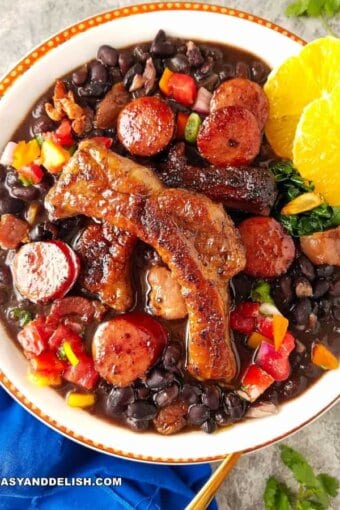
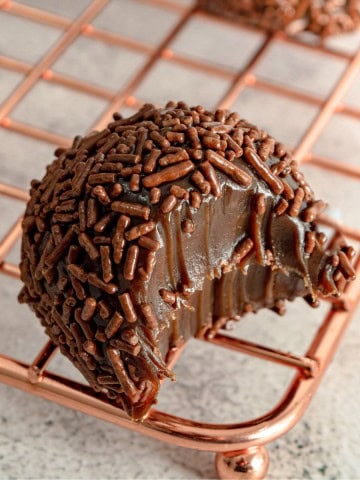


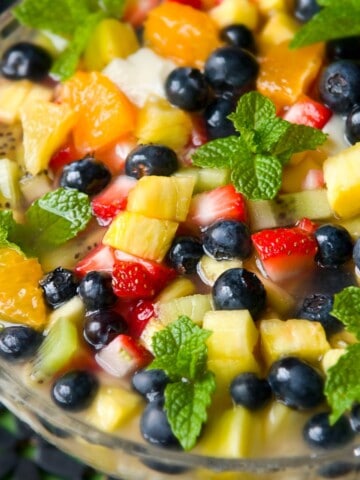
Amanda Santos says
Hi Denise, I’m Brazilian and I loved your recipe and all the website content. I loved the way you seasoned the Feijoada. This recipe is so delicious.
Thanks for sharing that amazing recipe with us. Feijoada reminds me of my childhood and so many parties and get-togethers. Trying your recipes made me revive that part of me, thank you so much. I live in West Virginia, so I had a hard time finding the ingredients, but luckily I came across a website when I could find truly Brazilian rice, beans, and farofa. You are amazing, thank you again!
Denise Browning says
Hi Amanda! I am so happy you were able to find some of our Brazilian products to pair with our feijoada recipe. I am even happier you enjoyed our recipe. Depending on the region or state you live in The USA it can be quite difficult to find Brazilian and other Latin food products. I have experienced that several times -- this is why sometimes I have to find suitable substitutes or adapt our recipes the best I can. Thanks a lot for stopping by. If you ever need anything, I will be happy to help you as much as I can. Um abraço!
Jens says
I found that the recipe lacked the depth of flavor I am used to from a feijoada. The reason for this is likely the lack of ears and tails from the recipe: they provide gelatin which creates a depth of flavor. I also found the lack of smokiness problematic. I take country style ribs and smoke them to add a bit of the smoky flavor. In my opinion, the beef stock interferes with the flavor so I would favor making it with chicken stock which is much closer to pork. I added the Tomato paste, but was not impressed by it. I like frying up onions, tomato, garlic, and parsley (or cilantro) and adding it at the end as it is a fresher taste than the tomato paste.
I think this is a good start but you need to go back to your roots and extract the real flavors of Brasil.
Beijos!
Denise Browning says
Hi Jens! I understand you prefer the old fashioned feijoada recipe -- with pieces of pork that most people don't eat or freak out to see in the dish. They certainly provide a more depth of flavor but I don't use them. Even down in Brazil, most people from my generation and younger don't eat them either. Americans much less! I still remember their faces' reaction when they saw pig's tail and other less noble parts of the pork in the feijoada. Some even refused to eat the feijoada. The ribs contain bones and provide enough gelatin in my opinion and of course, if you want to spend more time cooking ham hock, that would be a good one too. Smokiness is factor for Americans and is not present in most feijoada recipes, but if you enjoy go ahead. Tomato paste provide acidity which any bean recipe benefits from. Yes, frying vegetables at the end is used by some Brazilians but I find blending a portion of the seasoned and cooked frijoada itself in the blender is much more effective to add creaminess and extra flavor. It is also a common technique used by many Brazilians especially in the Northeast region and my state Pernambuco where the original feijoada come from (although many think it comes from Rio). I don't think I should go back to my roots because I am using preferences and techniques from my own Brazilian roots. There is not one way to make feijoada and only one recipe by the way. Sorry that you were disappointed by the way my generation prepares feijoada. I know many that have eaten or prepared this recipe and enjoyed. But you are entitled to your opinion. Thanks for stopping by. Beijos!
Josiah - DIY Thrill says
This black bean stew looks so yummy!
Heidi | The Frugal Girls says
What a delicious and flavor-packed stew... I love how you can make it in the Crock Pot or Instant Pot, too!
Denise Browning says
Thanks Heidi! Feijoada is indeed one of the best stews one can ever have. Only on Easy and Delish you can find instructions on how to make feijoada in the slow cooker, pressure cooker, and on the stovetop as well. Thank you for stopping by!
Mimi says
I’ve made feijoada once, and I can’t really remember how it differs from your recipe, but I definitely don’t remember using ribs. Your recipe sounds fantastic, and it’s so pretty!
Denise Browning says
Hi Mimi! Brazilians use all parts of the pork. Traditional feijoada recipes use more of the trimmings but most modern versions don't. It is more ribs, bacon, sausage, and pork meat stew.
April says
Farofa e feijoada nasceram uma para a outra e fazem a alegria da alma.
Betty loudermilk says
For 42 years I have searched for this recipe. I visited Rio in '74. I did not speak Portuguese and the little restaurant I had lunch in every day would just give me Feijoada. They didn't speak English). I had it with farofa and cooked kale. I loved it and am anxious to try this recipe. Thanks so much!
Denise Browning says
Thank you for sharing the experience that you had in Rio, Betty! I hope you try our recipe and enjoy it.
Patricia Cox says
Hi Denise,
I was lucky enough to live in Brasil for a year (a long, long time ago). I fell in love with feijoada and farofa. I had to make up what I thought was in it when I got back to the US. Black beans have become a staple in my house. My children loved feijoada too. I LOVE your recipe! I have never been able to find farofa though. Any ideas?
Pat
Denise Browning says
Hi, Patricia!
Thank you. I am glad that you enjoy our feijoada recipe. Farofa (or the manioc flour used to make the dish) is available in Brazilian markets or on Amazon.com. Please Google local Brazilian markets in your area or order from Amazon.com under 'Brazilian cassava flour'. There are 2 types: the white and the seasoned (this latter is a favorite of mine). I don't recommend American brands because their cassava flour are actually tapioca flour --- which contains a much finer grain than the Brazilian cassava flour that makes farofa. I hope this helps. Have a delicious week!!!
Chris says
I don't understand what to do with the ham hocks? So you boil them separately and then put them in with the beans? Not just put the hocks in with the beans from the get-go?
Denise Browning says
Hi, Chris!
The ham hocks are cooked in separate because they take longer to cook than the beans -- and we don't want wind up with overcooked beans. In addition, ham hocks smell horrible while cooking. 🙂 It is much better to cook them in separate and then add them to the beans according to the instructions.
Gabriel says
I'm with Chris on this one. The hocks are already smoked so the cooking time should be a similar amount of time as the beans. By cooking the hocks in a separate pot, you waste all those flavors and marrow that seeps out of them. Same with the brown bits from the bacon and the sausage.
Your recipe is fine as is. But i think your recipe is having folks send some great flavor down the drain.
Denise Browning says
The bacon, sausage and their fat is all added to the beans once browned. They are also added to the partially cooked beans and cooked for one hour at least with the beans.
You can place ham hock or, like I did, simply diced ham. The ham hock takes a long time to cook, way longer than the beans. By the time the ham hock has cooked, the beans are too soft. This recipe is quite flavorful. Please give it a try and come for a feedback. Thank you!
Don Black says
If you use a smoked "ham" hock it is also "cured" which means it is already "cooked" if it not "ham" it would be a pork "knuckle" or plain pork hock which does need cooking. I personally use a "smoked pork knuckle" and I prepare it in an oven before hand as I like the skin to be like that of "torresmo". To my understanding it just semantics.
Monicalee says
My mom always served feijoada with fresh sliced peaches and flour of manjoca not sure how it's spelt. Her and my father are both from Brazil.
Denise Browning says
Monicalee: Thanks for stopping by! The flour of mandioca is called farofa. Fresh peaches served with feijoada is a very unusual and personal accompaniment. Traditionally, sliced oranges are served with feijoada. I was born and raised in Brazil and have never ever seen feijoada served with peaches. Wishing you a great weekend!
Moi says
just like cassoulet, just black beans instead of white!
Denise Browning says
Feijoada is similar to cassoulet indeed.
Claudio says
Denise adorei a receita, não vejo a hora de poder usar. Obrigado pelas dicas.
Denise Browning says
De nada, Claudio! Espero que você possa fazer e gostar. A felicidade aqui em casa ontem - e também hoje - foi geral!!! 🙂 Um excelente fim de semana para você e sua família.
tasteofbeirut says
This is one dish I fondly remember as my then (now passed) friend Ana made it for us one happy Sunday. What a wonderful meal that was!!! Still mouthwatering when I think of it!
Denise Browning says
Joumana: Thanks so much for your comment. I do appreciate it. I am glad that you have lovely memories of this dish, which was shared by your friend Ana. I am so sorry for her passing. I hope you can make and enjoy feijoada again in the future. Congrats on your Saveur nomination!